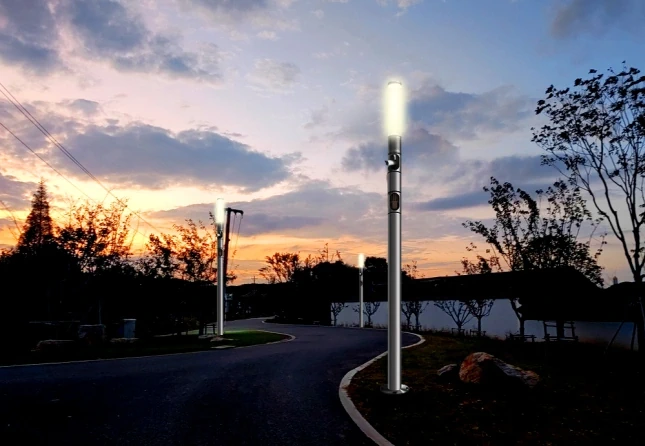The Design Trends of Smart Courtyard Lamp Posts
With the rapid development of the Internet of Things (IoT), artificial intelligence, and new energy technologies, courtyard lighting is undergoing a profound intelligent transformation. In 2025, the design of courtyard lamps is no longer limited to basic lighting functions but is evolving towards high integration, personalized scenarios, and eco-friendly directions. The gradual replacement of traditional courtyard lamps by smart lamp posts has become an inevitable trend. This article will comprehensively analyze the latest design trends of smart courtyard lamp posts, from technical architecture to application scenarios, from user experience to sustainable development, presenting a complete picture of the future of courtyard lighting.
I. Comprehensive Upgrade of Multimodal Interaction Systems
The human-machine interaction methods of smart courtyard lamp posts are undergoing revolutionary changes, evolving from a single physical switch or mobile app control to a diversified natural interaction system.
-
Voice Control 3.0 Era: The new generation of smart courtyard lamp posts is equipped with offline voice recognition chips, supporting multilingual hybrid commands and fuzzy semantic understanding. Users can control the lighting through natural conversation, such as “Dim the lawn lights to create a romantic atmosphere,” and the system can accurately parse compound instructions. Some high-end products have already implemented voiceprint recognition, allowing different family members to enjoy personalized lighting schemes.
-
Gesture and Motion Interaction: By integrating millimeter-wave radar and 3D ToF sensors, smart courtyard lamp posts can recognize specific gestures (such as waving to adjust brightness or drawing a circle to switch scenes) and human postures. When an elderly person falls, the system will automatically enhance lighting and send an alarm, realizing safety protection functions.
-
Environment-Adaptive Interaction: Smart lamp posts adjust their interaction methods based on environmental noise levels—switching to vibration feedback or visual prompts in noisy environments and prioritizing soft voice prompts in quiet residential areas, reflecting a human-centered design philosophy.
-
Case in Point: A 2025 new model of a smart courtyard lamp post from an international brand integrates a 16-microphone array and a thermal imaging sensor, capable of recognizing voice commands within a 5-meter radius while also detecting user discomfort through body temperature.
II. Deep Integration of AIoT Technology into Smart Ecosystems
Modern smart courtyard lamp posts have evolved into key nodes of residential IoT, forming a fully interconnected intelligent ecosystem.
-
Distributed Edge Computing Architecture: The new generation of smart courtyard lamp posts is equipped with AI processing units that can perform tasks such as facial recognition and behavior analysis at the device level, reducing dependence on the cloud. Multiple lamps can self-organize into a Mesh network, maintaining basic intelligent functions even when offline. Huawei’s latest HiLink solution supports millisecond-level coordinated response of over 200 devices within a single courtyard.
-
Seamless Integration with Multiple Systems: Modern smart courtyard lamp posts have achieved deep integration with security systems (surveillance cameras, electronic fences), irrigation systems (soil moisture sensors), and entertainment systems (outdoor speakers). When an intruder is detected, the lamps can automatically track the movement and flash warnings; they can also adjust the growth light spectrum based on soil data.
-
Digital Twin Visualization Control: Through 3D modeling technology, users can view the real-time status of smart lamp posts on their mobile devices as three-dimensional projections, directly adjusting actual lighting parameters by clicking on the virtual model. Some systems support AR previews, allowing users to see the actual effects of different lighting schemes before installation.
-
Technical Indicator Comparison: Traditional smart lamps have a response delay of about 500ms, while the flagship smart lamp posts of 2025 have reduced this to within 80ms; the number of networked devices has increased from 20 to over 200; and local AI computing power has reached 4TOPS.
III. Innovative Integration of Sustainable Design and New Energy Technologies
The concept of environmental protection has deeply penetrated every aspect of smart courtyard lamp post design, forming a green solution throughout the entire life cycle.
-
Integration of Photovoltaics, Energy Storage, and Lighting: The latest generation of solar courtyard lamps uses PERC double-sided power generation technology with a conversion efficiency of 24.5%, combined with solid-state lithium battery energy storage, which can maintain lighting for 7 days during continuous rainy weather. Some products innovatively integrate miniaturized wind power generation into the lamp post design, creating a wind-solar complementary system.
-
Application of Biodegradable Materials: Leading manufacturers have begun to use renewable materials such as bamboo fiber composites and mycelium-based materials to make lamp body casings. Philips’ “Back to Nature” series has a natural degradation rate of up to 90% within six months after disposal, and the decomposition process does not produce toxic substances.
-
Energy-Saving Algorithm Optimization: An adaptive dimming system based on reinforcement learning can learn the activity patterns of family members and predict lighting needs. The system will dynamically adjust lighting strategies based on factors such as moonlight intensity, weather conditions, and human traffic density, saving 40%-65% energy compared to traditional solutions.
-
Environmental Protection Data: In 2025, the carbon footprint of top-tier solar smart lamp posts has decreased by 58% compared to 2020; light efficiency has increased from 120lm/W to 210lm/W; and the proportion of renewable materials used has reached 35%.
IV. Health-Oriented Lighting Environment Design Philosophy
In the post-pandemic era, people are paying increasing attention to the health impact of outdoor lighting environments, giving rise to a new generation of healthy lighting solutions.
-
Human Circadian Rhythm Adaptation Technology: Smart courtyard lamp posts can automatically adjust color temperature based on local time (5000K invigorating white light in the morning, 3000K soothing yellow light in the evening) and control the proportion of blue light (<15%) to reduce the inhibition of melatonin. Osram’s BioLight system can even adjust the light recipe based on user physiological data collected from wearable devices.
-
Space Disinfection Function: Some high-end courtyard lamps integrate UVC-LED modules to activate short-wave ultraviolet disinfection programs during unmanned periods, irradiating and sterilizing frequently touched surfaces in the courtyard (such as doorknobs and railings). Safety sensors ensure that UVC is automatically turned off when human activity is detected to avoid harm.
-
Air Quality Improvement: Innovative products such as Haier’s “Light Purify” series integrate photocatalytic oxidation technology into the lamps, using specific wavelengths of light to activate TiO2 coatings to decompose pollutants such as formaldehyde and VOCs in the air while releasing negative ions.
-
Health Benefit Research: In courtyards with healthy lighting environments, users’ average nighttime sleep onset time is shortened by 22 minutes; the synchronization rate of daily light rhythms is increased by 37%; and the microbial load in outdoor spaces is reduced by 68%.
V. New Heights in Scenario-Based and Emotional Design
Contemporary courtyard lighting has transcended the functional level, focusing on creating experiential designs that evoke emotional resonance and memorable moments.
-
Dynamic Scene Engine: Advanced scene systems support “seasonal perception” functions, automatically invoking four basic light environment schemes for spring freshness, summer coolness, autumn warmth, and winter sunshine. Users can also customize “anniversary mode” to recreate special lighting effects on specific dates.
-
Emotional Interaction Design: Courtyard lamps are beginning to have simple “emotional expression” capabilities, with light color changes reflecting their status. For example, when the battery is low, it displays a “tired” breathing orange light, and when the network connection is interrupted, it shows a “confused” flashing blue light, enhancing product affinity.
-
Community Interconnection Function: Innovative community lighting networks allow adjacent courtyards to share light environment data. When one household hosts a party, the surrounding courtyard lamps can automatically adjust to coordinated auxiliary lighting, avoiding light interference while creating a harmonious atmosphere. The “balcony concert” mode that emerged during the pandemic allows the entire block’s lights to synchronize with the music rhythm.
-
User Experience Data: The user satisfaction rate for courtyard lamps with emotional design reaches 92%, 29% higher than traditional products; the average weekly use frequency of scene modes is 11.3 times; and the community interconnection function increases neighborhood interaction frequency by 40%.
VI. Modular and Evolvable System Architecture
To cope with the rapidly evolving technological environment and personalized demands, the hardware architecture of courtyard lamps is becoming highly flexible.
-
Plug-and-Play Functional Modules: Users can add modules such as cameras, air quality monitoring, and WiFi expansion according to their needs. LG’s NanoCellLight uses a standardized interface, with all modules supporting hot swapping, allowing upgrades without professional tools.
-
Software-Defined Lighting: Through OTA (Over-The-Air) updates, smart courtyard lamp posts can continuously gain new functions. In 2024, Xiaomi’s ecosystem launched the “Tree of Light” system, which has achieved monthly functional iterations, with users even able to subscribe to regular light scene update services provided by professional designers.
-
Open Developer Ecosystem: Mainstream platforms such as Apple Home and Google Fuchsia have provided courtyard lamp SDKs, allowing third-party developers to create unique light effect applications. An active creator community has already formed, sharing innovative solutions from “aurora simulation” to “insect-friendly lighting.”
-
Expandability Indicators: Modular design extends the product life cycle to 8-10 years; leading brands offer OTA


